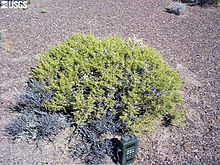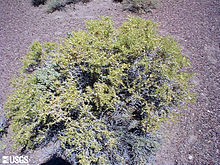Sarcobatus: Difference between revisions
Sylfred1977 (talk | contribs) fr |
|||
| Line 29: | Line 29: | ||
*''Sarcobatus vermiculatus'' ([[William Jackson Hooker|Hook.]]) [[John Torrey|Torr.]]. Throughout the range of the genus. Shrub 1–5 m tall. Leaves hairless or only slightly hairy, 15–40 mm long. |
*''Sarcobatus vermiculatus'' ([[William Jackson Hooker|Hook.]]) [[John Torrey|Torr.]]. Throughout the range of the genus. Shrub 1–5 m tall. Leaves hairless or only slightly hairy, 15–40 mm long. |
||
The name ''Sarcobatus'' comes from [[Greek language|Greek]] ''sarko'' (meaning ''flesh'') and ''batos'' (meaning ''bramble''), referring to the species' spiny branches and [[succulent]] leaves. |
The name ''Sarcobatus'' comes from [[Greek language|Greek]] ''sarko'' (meaning ''flesh'') and ''batos'' (meaning ''bramble''), referring to the species' spiny branches and [[succulent]] leaves. oh yeah baby i love samuel cervantez goes to foster middle school ☺ i hate jocelyn!!! |
||
==External links== |
==External links== |
||
Revision as of 16:43, 28 January 2010
| Greasewood | |
|---|---|

| |
| Scientific classification | |
| Kingdom: | |
| Division: | |
| Order: | |
| Family: | |
| Genus: | Sarcobatus Nees (1839)
|
| species | |
|
see text | |
Greasewood (Sarcobatus) is a genus of one or two species of flowering plants. Traditionally it has been treated in the family Chenopodiaceae, but the APG II system, of 2003, places it in the family Sarcobataceae.


The plants are deciduous shrubs growing to 0.5–3 m tall with spiny branches and succulent leaves, 10–40 mm long and 1–2 mm broad. The leaves are green, in contrast to the grey-green color of most of the other shrubs within its range. The flowers are unisexual and appear from June to August. The species reproduces from seeds and sprouts. The green or tan fruit is small and winged. Small brown seeds are contained inside the fruit.[1]
Their area of distribution is western North America, from southeastern British Columbia and southwest Alberta, Canada south through the drier regions of the United States (east to North Dakota and west Texas, west to central Washington and eastern California) to northern Mexico (Coahuila).
Greasewood is a halophyte, and is commonly found in sunny, flat areas around the margins of playas and in dry stream beds and arroyos. It is replaced by iodine bush in extremely saline environments, such as hummocks within the playa itself. Greasewood often grows in extensive, nearly pure stands in pluvial desert locations. Greasewood does not grow exclusively in highly saline areas, but is most common on fine-grained soils in areas with a relatively high water table.
Although it can be grazed by animals that are adapted, grazing of greasewood by sheep and cattle can result in oxalate poisoning resulting in kidney failure [1]. The active agent can be either sodium oxalate or potassium oxalate. Sheep are the most vulnerable. Greasewood was commonly used for firewood by Native Americans and early settlers.
Species

The two species are not accepted as distinct by all authors; see the Flora of North America for further details.
- Sarcobatus baileyi Coville (syn. Sarcobatus vermiculatus var. baileyi (Coville) Jepson). Nevada, endemic. Low shrub 0.5–1 m tall. Leaves hairy, 10–16 mm long.
- Sarcobatus vermiculatus (Hook.) Torr.. Throughout the range of the genus. Shrub 1–5 m tall. Leaves hairless or only slightly hairy, 15–40 mm long.
The name Sarcobatus comes from Greek sarko (meaning flesh) and batos (meaning bramble), referring to the species' spiny branches and succulent leaves. oh yeah baby i love samuel cervantez goes to foster middle school ☺ i hate jocelyn!!!
External links
- Flora of North America: Sarcobatus
- Jepson Flora: Sarcobatus vermiculatus
- Extensive description with images explorenm.com, Explore New Mexico
- USDA National Database
- University of Saskatchewan info
- Utah State University info
- Oregon State University info
- University of Montana info pdf file html file
